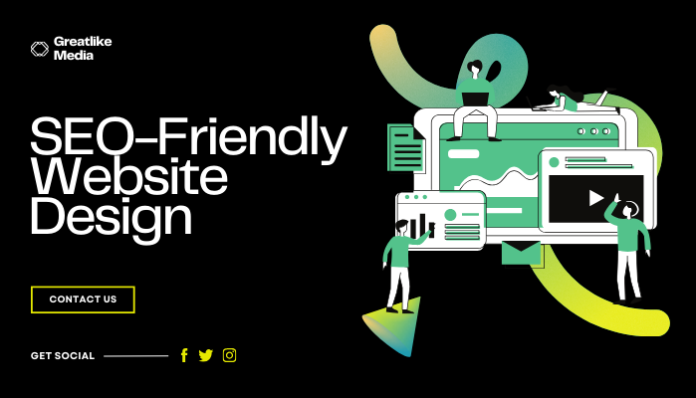In this digital era where answers are just a click away, it’s crucial for businesses to pop up where it matters most – right at the top of search engine results. Google.com had 85.3 billion visits in July 2023. So, what’s the secret sauce to stay ahead?
Well, it’s a blend of SEO (Search Engine Optimization) and skillful website design. Let’s delve deeper into the magic of SEO-geared website design and its transformative power on business expansion.
What Does “SEO-Friendly Website Design” Mean?
SEO-friendly design isn’t merely about a sleek look. At its core, it’s about a website sculpted with SEO’s best practices, ensuring it’s easy for search engines to scan, comprehend, and list its content. Let’s unravel the essential elements that give life to such a design:
● A Thoughtful Information Layout
Picture a neatly stacked bookshelf. A website, too, should have its content laid out thoughtfully, moving seamlessly from broad topics to detailed insights. This orderly arrangement clues search engines into the essence and importance of each page.
● Clean and Semantic Coding
Behind the scenes of every website lies a tapestry of code. Search engines are fans of websites with neat, structured, and meaningful coding. Proper use of HTML tags, like H1 for headlines and H2 for subtitles, is a key player here.
● URL Structure
SEO-adapted websites boast URLs that are a breeze for both users and search engines to decode. Take, for example, www.example.com/services/digital-marketing. This is far more intuitive than a cryptic www.example.com/page123?id=456. The former gives a clear hint about the content, while the latter leaves us scratching our heads.
● Integration of Metadata
Even if they’re out of sight on the live page, meta titles, and descriptions are the unsung heroes of search rankings and user clicks. A design that’s SEO-conscious will weave in these elements, ensuring each page stands out with unique and informative meta details.
● Incorporating Internal Linking
Imagine creating bridges between various pages of your website. That’s what internal linking does. Besides boosting the authority of your pages, it offers search engines valuable insights into the interconnectedness and significance of your content.
● Optimal Multimedia Usage
Unlike us, search engines can’t “visualize” pictures or videos. That’s why SEO friendly website design insists on descriptive alt texts, captions, and whenever feasible, transcripts for every media item. This gives search engines a lens to grasp the content and role of each multimedia piece, aiding in better ranking.
● Future-Ready Design
As businesses blossom, their websites need room to flourish too. Be it adding fresh content, pages, or even features; the design must ensure that these tweaks don’t shake the SEO foundation. A future-proof design stays adaptable and resilient, safeguarding the site’s SEO core.
Why Does SEO-Friendly Website Design Matter?
SEO friendly website design is not just a buzzword but a critical factor for online success. Its importance cannot be understated in our digital-first world. To truly understand its significance, let’s dissect the core reasons:
1. Visibility in Search Engines:
- Dominating Organic Searches: Search engines have one goal – serving users the best of content. By aligning your site with SEO principles, you will make your site more likely to appear in top search results.
- Changing Algorithms: The rulebooks for search engines keep getting revised. However, sites built on sturdy SEO ground tend to dance along with these shifts, ensuring their standing remains robust or even ascends.
- Building Brand Credibility: Consistently appearing atop for vital searches isn’t just about clicks – it cements your brand’s reputation. Typically, users place their trust in brands that consistently pop up in their search results.
2. Enhanced User Experience:
- Meeting User Expectations: Modern SEO is a two-way street, catering to search engines and user experience. Centering your content around audience-relevant topics means you’re crafting a site that resonates with their needs, pushing engagement up.
- Reducing Bounce Rate: A website that’s not just SEO-tailored but also user-centric ensures visitors swiftly find what they’re hunting for, curbing the odds of them bouncing back to other sites.
- Smooth Sailing Navigation: A seamless navigational experience is a twin win – it’s a nod to good design and SEO. When your website feels intuitive, users linger, signaling search engines about your site’s worth.
3. Adapting to Technological Changes:
- Mobile Optimization: Over 60% of all internet traffic comes from mobile devices. Given the surge in mobile-based searches, search engines have a soft spot for mobile-friendly sites. Hence, an SEO-driven website design typically aligns with mobile responsiveness.
- Ready for Voice: With virtual assistants like Siri and Alexa gaining traction, optimizing for voice searches is the order of the day. SEO-centric sites are attuned to this, shaping content to fit voice search’s nuances.
4. Long-term Cost Efficiency:
- Organic Traffic Over Paid: While shelling out for ads can bring quick results, it might strain your pockets over time. SEO-friendly sites, on the other hand, bring organic traffic, sidestepping the persistent costs tied to paid drives.
- Maintenance and Updates: A website designed with SEO in mind is generally more structured. Their organized nature means any future tweaks or overhauls can be executed smoothly, without hampering the site’s SEO rhythm.
5. Competitive Edge:
- Staying Ahead: The digital arena is brimming with competition. An SEO-aligned site provides an edge, ensuring your brand doesn’t drown in the sea of content.
- Future-proofing Your Online Presence: The digital landscape is ever-evolving. Yet, websites grounded in SEO principles are better equipped to morph with these shifts, keeping you ahead in the race.
Benefits of an SEO-friendly Website Design for Business Growth
● Increased Organic Traffic
One of the most tangible perks of an SEO-ready website? A remarkable upsurge in organic visitors. When we say ‘organic’, we’re talking about those individuals who stumble upon your website without any paid prompts.
With a design tailored to SEO, your website is bound to enjoy the limelight on search engine result pages (SERPs) for the right keywords. Moreover, unlike paid promotions which see a dip post-campaign, this organic flow, with consistent SEO efforts, only grows.
● Improved User Trust and Credibility
Let’s be honest – we often equate a top search rank with credibility. Every time your site makes its appearance atop search listings, it’s like a silent endorsement of your brand’s reliability.
Furthermore, an SEO-tuned design usually means a well-laid-out site, crisp navigation, and content that adds value. All of this further deepens user trust. Remember, in today’s digital realm, you rarely get a second chance at first impressions, and a site tailored for SEO ensures yours is both memorable and positive.
● Cost-Effective Growth
While SEO design might ask for an upfront investment, the dividends it pays over time are unmatched. Imagine not having to constantly feed into paid ad campaigns.
Just a singular effort in SEO-focused design keeps giving back. The cherry on top? Leads from organic search usually convert better, assuring a stellar ROI.
● Competitive Advantage
The digital market is saturated with brands, each fighting for attention. An SEO-tweaked site automatically gains a higher rank, making it more visible than its peers. Especially in niches where SEO’s power is underestimated, a well-optimized site can make your brand the undeniable front-runner.
● Enhanced Engagement and Conversions
It’s not just about drawing visitors; it’s about making them stay. An SEO-tweaked design, with clear action prompts, user-friendly pathways, and content that resonates, often sees visitors turning into customers. This customer-centric design not only pushes sales but fosters brand devotion.
● Localized Reach and Engagement
Local SEO is the unsung hero of the digital age. An SEO friendly website design takes into account local search optimization, ensuring that businesses reach their local audience effectively.
This local focus is a boon for physical stores or region-specific services. When someone hunts for something “near me” or specific to a region, your business becomes their go-to.
● Future-Proofing Your Digital Strategy
The digital landscape is ever-shifting, thanks to constant algorithm tweaks. But an SEO-infused design, crafted with today’s best strategies, also readies itself for tomorrow’s changes. This forward-thinking approach ensures that when others are catching up, you’re leading the charge.
Conclusion
The design of your website is more than just aesthetics; it’s a strategic tool in the digital battleground. It goes beyond merely wooing search engines; it’s about crafting an enriching journey for every visitor. As the digital sphere becomes increasingly competitive, embedding SEO in your website’s DNA isn’t just a smart move—it’s imperative for business success and longevity.
Author Bio:
Justin Rath, Website design & development Consultant from Orange County, CA, has over ten years of experience in creating engaging website design and development. He is a tech enthusiast who publishes material to inform readers about various technologies and their related trends.



















